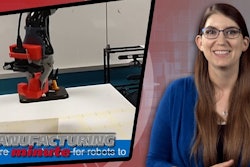The internet of things (IoT) is taking businesses by storm.
The total value of the IoT market may top $1.5 billion by 2021 while more than 80 percent of companies will have adopted the IoT before the end of next year. Manufacturers, however, aren’t as quick to embrace this new level of connectivity. In fact, nearly 75 percent of manufacturers have yet to fully implement IoT technology.
Although such patience may have served manufacturers well in the past, exercising similar caution may mean missing out on valuable benefits. From improved quality assurance and predictive maintenance to greater efficiency, metalworking is one area of manufacturing that stands to see big benefits from the IoT.
Superior Product Quality
Quality often takes priority over quantity in metalworking. And it’s not difficult to see why. The fewer errors there are within a product, the better the odds customers will come back for more. Metalworkers looking to consistently deliver high quality products can start by leveraging IoT sensors.
Whether it’s nailing down the effects transportation has on a final product or tracking the temperature of metals throughout the production process, IoT sensors provide plenty of added insight. Instead of assuming you’re taking every precaution needed to craft a top-notch product, modify your production process based on real-time data. If, for example, variables such as the composition of raw materials make it difficult to ensure the same degree of quality within each product, new manufacturing procedures may need to be put in place.
A steady stream of data from final products promises to provide more ideas for enhancing product quality moving forward. IoT sensors can also help pave the way for increased customer satisfaction by capturing both positive and negative consumer sentiment.
Minimal Downtime
While it’s impossible to prevent metalworking robots and machines from breaking down over time, there are a few steps you can take to minimize maintenance costs. Rather than guessing when mechanical problems may arise, use data collected by IoT sensors to better prepare for issues.
This improved understanding of equipment health may go a long way toward boosting your bottom line. In fact, predictive maintenance can increase equipment availability by 10 to 20 percent and also reduce total maintenance costs by 5 to 10 percent. Repairs that may have previously taken weeks or months can be shortened significantly thanks in large part to a more proactive approach made possible by connected devices. Addressing an issue before it gets out of hand helps avoid costly repairs that can leave equipment out of commission for extended periods of time.
Better yet, advanced notice of potential repairs can ease the burden you may face when trying to plan around downtime. All too often, unexpected issues leave you and your workers empty handed. But with IoT sensors, such surprises may soon become a thing of the past.
Streamlined Operations
Efficiency has the power to impact an organization in more ways than one. Not only does greater efficiency give employees the opportunity to focus their attention elsewhere, but it also sets the stage for a shorter time to market. If you’re hoping to reap such rewards, consider bringing aboard the IoT.
By enabling metalworking solutions to give employees a heads up when specific tasks are completed, the IoT can help reduce the time it takes to advance products throughout the manufacturing process. Protracted workflows that currently require employees to check up on product development throughout the day may soon give way to instant alerts.
With access to real-time information right at your fingertips, you’ll have the luxury of staying in the loop on relevant issues and adjusting schedules accordingly. If a product is moving through the metalworking process more slowly than usual, employees can use connected devices to quickly become aware of such problems and avoid waiting around for updates that may be few and far between. Time that was once devoted toward determining which stage of development a product is at can instead be used to tackle more pressing matters.
The IoT is set to skyrocket over the next few years. But in order to make the most of this significant rise, you need to take action sooner rather than later. A wide range of benefits – including increased product quality, less costly repairs and more efficient operations – are available to those who act fast.
Joe Gemma is the chief regional officer at KUKA Robotics.























